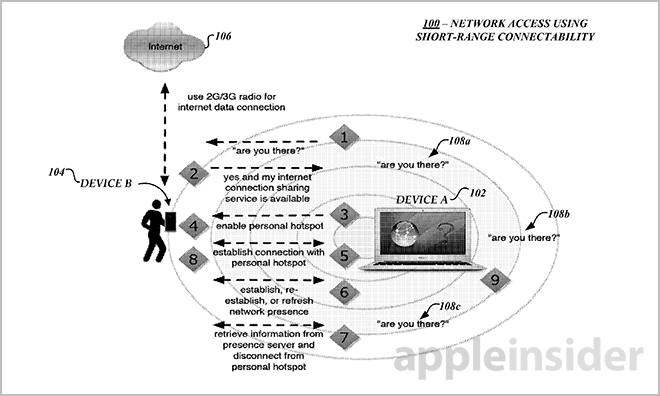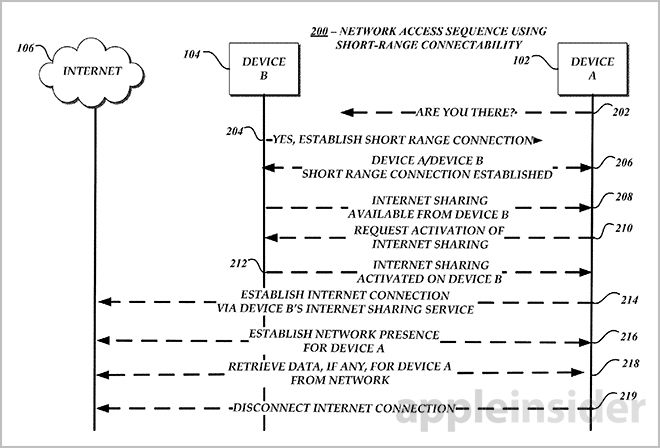An Apple patent filing published on Thursday by the U.S. Patent and Trademark Office details a wireless network sharing technology that leverages low-power Bluetooth instead of Wi-Fi, making it a prime candidate for small devices like the much-rumored "iWatch."

Source: USPTO
In its application for "Network access using short-range connectability," Apple proposes a method by which a device can connect to, and share a network with, a second device via low-power communications, such as Bluetooth.
Specifically mentioned in the document is a primary device that has the ability to establish a connection with a remote network, but may not have a built-in radio transceiver, as would a smartphone. A second device, which has such a radio, is paired to the first and can provide the necessary communications access by allowing the first device to pair and share data over protocols such as Bluetooth. This also lets the primary unit stay in a low-power state, thereby increasing battery life.
The invention works much like existing Bluetooth tech. A supporting device, such as an iPhone, can broadcast a signal, advertising the availability of its shared network to other electronics within range. In turn, the device without a cellular radio can send a request to pair with the host, asking that its network sharing be activated. Pairing takes place when the supporting machine activates the shared network and begins sending data to the first device. All this is done without user intervention.

Apple intends for the hotspot pairing to be brief, leaving enough time to obtain push notifications, messages, emails, news and other Web-based assets. In one embodiment, the first device establishes or re-establishes a connection with a remote cloud server, like iCloud, for various updates. Once this task is complete, the shared connection is severed by the host device, allowing both units to return to a low-power sleep mode.
From the filing's description:
In this manner, users can leverage their mobile radio communication devices, such as their cell phones, to provide network access to their other devices without having to manually enable such connections. In turn, the other devices can benefit from the network access while remaining in low-power mode during a short-range connection that uses a low-power enabled connection.
Although the invention makes no mention of a watch, the tech's low-power data transfer capabilities are in line with features some speculate will be incorporated into the so-called "iWatch." For example, the wearable device may rely on another iDevice for heavy computation and other power-hungry operations via Bluetooth, making it somewhat of a "headless" product. This idea was first seen in an Apple patent application published earlier this year.
It should be noted, however, that other industry watchers see Apple building in Wi-Fi connectivity and possibly high-functioning components like GPS modules. Alternatively, the purported watch may use the above described technology as means of power savings, while still sporting Wi-Fi and other advanced communications hardware.
The most recent iWatch rumors point to the inclusion of a low-energy, flexible OLED display manufactured by LG, though specifics are scarce as usual.
Apple's short-range communications patent application was filed for in March and credits Daniel Borges, Michael Jason Giles, and Michael Larson as its inventors. The invention first passed the USPTO's desk as a provisional patent application in 2012.